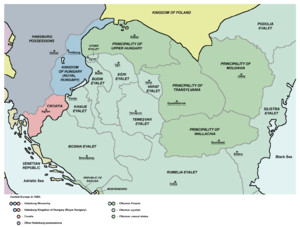Principality of Upper Hungary
| Principality of Upper Hungary Felső-Magyarországi Fejedelemség Orta Macar | |||||||||
|---|---|---|---|---|---|---|---|---|---|
| 1682–1685 | |||||||||
 Principality of Upper Hungary in 1683 | |||||||||
| Status | Vassal state of the Ottoman Empire | ||||||||
| Capital | Kassa (present-day Košice) | ||||||||
| Government | Principality | ||||||||
| Prince | |||||||||
| History | |||||||||
• Established | November 19 1682 | ||||||||
• Disestablished | October 15 1685 | ||||||||
| ISO 3166 code | HU | ||||||||
| |||||||||
| Today part of | Hungary, Romania, Slovakia, Ukraine | ||||||||
The Principality of Upper Hungary[1] (Hungarian: Felső-Magyarországi Fejedelemség; Turkish: Orta Macar, "Middle Hungary") was a short lived Ottoman vassal state ruled by Imre Thököly.
Background
The region of Upper Hungary was considered to be an appanage principality, and it was usually managed by the heir of Hungarian throne, or by a brother of the reigning king. This territory would be administrated from the city of Pozsony (German: Pressburg, today's Bratislava).[2] After peace treaty of Vasvár was signed in 1664, loyalty felt by Hungarians towards Habsburg dynasty was in decline. Imperial administration acted against interests of the Hungarian estates. In 1671 a rebellion was successfully thwarted. However, a year later Mihály Teleki led a more successful rebellion. In 1680 Imre Thököly became the leading figure of the rebellion. These rebellions were supported and sustained by the Ottoman state and the Principality of Transylvania.[3][4]
Establishment and later history
The principality was established on 19 November 1682.[5] The polity agreed to pay 20,000 gold to the Ottomans annually.[6] In 1685 Thököly was defeated at Eperjes (present-day Prešov) and the Turks imprisoned him because of his previous negotiations with Leopold therefore his realm ceased to exist.
See also
References
- ↑ Hadtörténelmi közlemények, Volume 118, Issues 3-4, Hadtörténeti Intézet és Múzeum, 2005, p. 409
- ↑ William Mahoney (18 February 2011). The History of the Czech Republic and Slovakia. ABC-CLIO. p. 34. ISBN 978-0-313-36306-1.
- ↑ Balázs Trencsényi; Márton Zászkaliczky (2010). Whose Love of Which Country?: Composite States, National Histories and Patriotic Discourses in Early Modern East Central Europe. BRILL. p. 547. ISBN 90-04-18262-4.
- ↑ István Keul (2009). Early Modern Religious Communities in East-Central Europe: Ethnic Diversity, Denominational Plurality, and Corporative Politics in the Principality of Transylvania (1526-1691). BRILL. p. 219. ISBN 90-04-17652-7.
- ↑ J. János Varga, A fogyó félhold árnyékában, Gondolat, Budapest, 1986, p. 31
- ↑ "Kereszt és félhold". mek.oszk.hu.